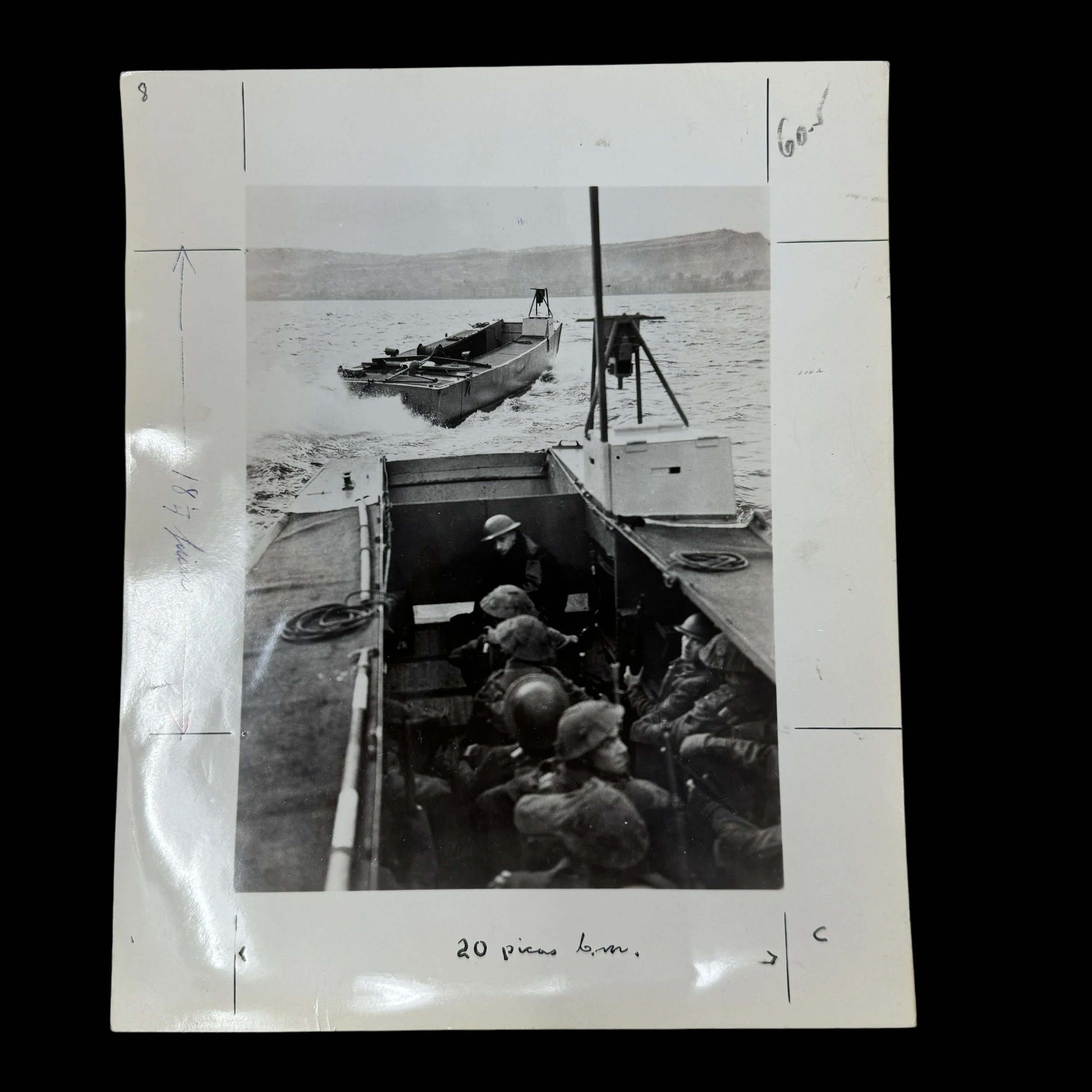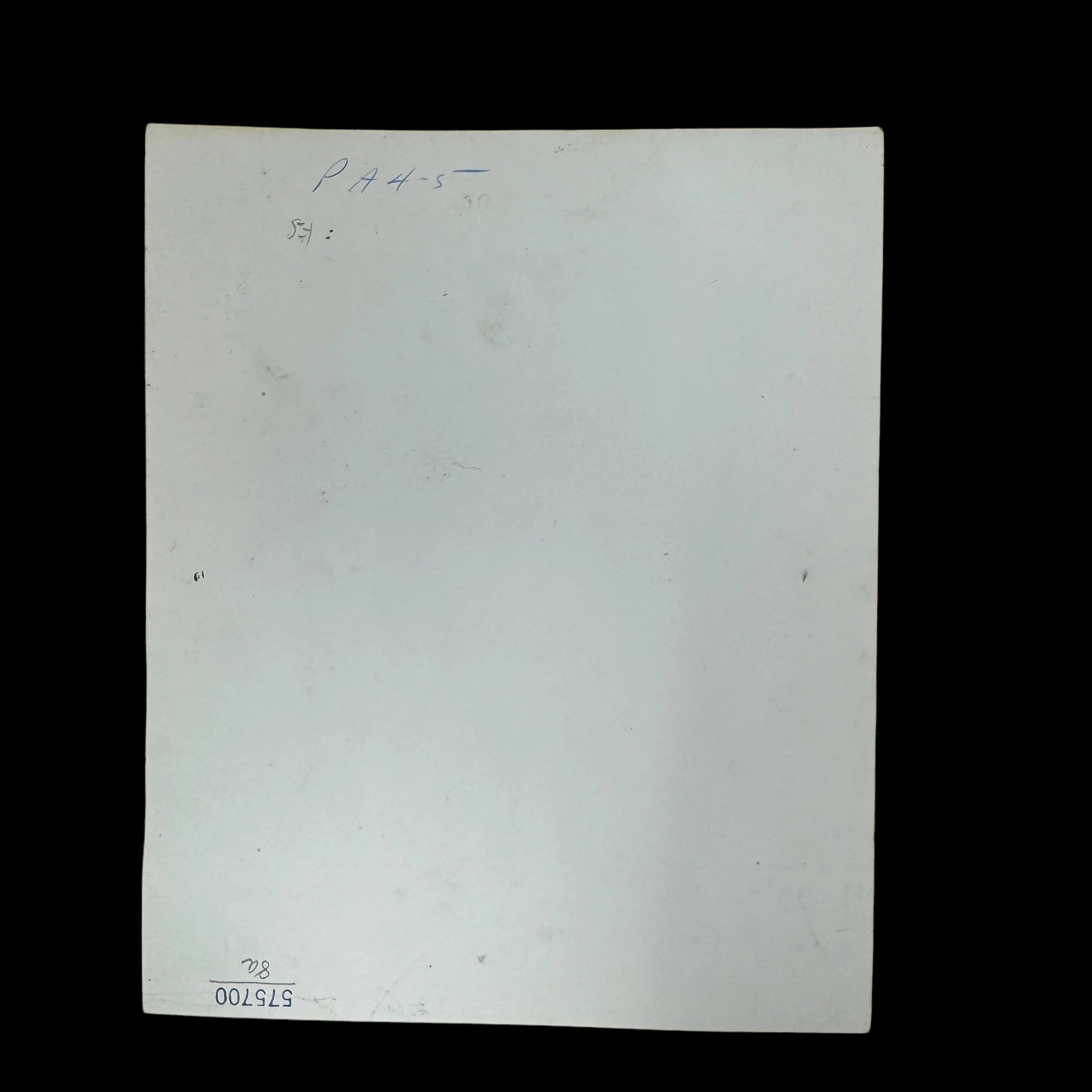RARE! WWII "Type 1" Landing Craft Assault (LCA) Military Intelligence Combat Action 8.25 × 10 Photograph















RARE! WWII "Type 1" Landing Craft Assault (LCA) Military Intelligence Combat Action 8.25 × 10 Photograph
Comes with hand-signed C.O.A. and a full historical write-up
Size: 8.25 × 10 inches
This incredibly rare and museum-grade TYPE ONE original military intelligence photograph of the WWII Landing Craft Assault (LCA). This rare Type 1 photograph showed a detailed view of the Landing Craft Assault in the combat zone with British soldiers approaching the invasion beachhead.
The Landing Craft Assault (LCA) During World War II
The Landing Craft Assault (LCA) played a pivotal role in amphibious operations during World War II, acting as the main vessel used to transport infantry troops from larger ships to the beaches during key assaults. These specialized craft were designed to navigate the perilous journey from ship to shore, crossing open water and then pushing through enemy defenses to land troops directly onto hostile beaches. The LCAs were fundamental in some of the most significant amphibious landings of the war, including the D-Day landings in Normandy, Operation Torch in North Africa, and many others in the Pacific and European theaters. This essay will explore the design, evolution, and critical importance of the LCA, highlighting its contribution to Allied success in WWII.
Design and Development of the Landing Craft Assault
The need for a specialized vessel capable of landing troops directly on beaches became apparent early in the war. The British Royal Navy spearheaded the development of the LCA, which was specifically designed for stealth, protection, and mobility. Its origins can be traced back to the interwar period when British military planners anticipated the need for amphibious warfare based on experiences from World War I. With the advent of WWII and the looming need for large-scale landings in Europe and the Pacific, the development of amphibious craft took on new urgency.
The LCA was built primarily of wood with steel plating on its sides to offer some protection against small-arms fire. The use of wood not only helped reduce the weight of the craft but also minimized magnetic mine risks. Its size was relatively small, measuring 41 feet in length and 10 feet wide, and it could carry up to 36 fully equipped soldiers. The flat bottom of the craft allowed it to land on beaches, while its shallow draft enabled it to approach shorelines even in waters as shallow as 18 inches.
One of the most critical design features of the LCA was its retractable ramp at the front. This ramp allowed soldiers to disembark quickly once the craft reached the shore. The soldiers would rush out directly onto the beach, giving them the ability to storm enemy defenses in the shortest possible time. The LCA was powered by two Ford V-8 petrol engines, providing a top speed of around seven knots. While not particularly fast, the craft's strength lay in its capacity to maneuver under difficult conditions and deliver troops precisely to their intended landing zones.
The Role of the LCA in Amphibious Operations
The LCA’s versatility made it an integral part of amphibious assaults across multiple theaters of WWII. It was deployed in operations involving large numbers of troops and was often the first craft to make landfall during such operations, ferrying soldiers to the beachhead in the face of intense enemy resistance.
D-Day and the Normandy Landings
One of the most famous operations involving the LCA was the D-Day landings on June 6, 1944. On this day, the Allied forces executed Operation Overlord, the largest amphibious invasion in history, to establish a foothold in Nazi-occupied France. The Normandy coast, heavily fortified by the Germans, posed a formidable challenge for the landing forces. The LCAs played a critical role in transporting the first waves of troops, including American, British, and Canadian forces, onto beaches like Omaha, Utah, Sword, Gold, and Juno.
At Omaha Beach, for instance, LCAs faced a brutal reception. German machine guns, artillery, and mines inflicted heavy casualties on the soldiers disembarking from the LCAs. Nevertheless, the bravery of the crews and the soldiers aboard these craft allowed the landings to continue, and despite significant losses, the beachhead was eventually secured. The LCAs made multiple trips back and forth, carrying additional waves of infantry, engineers, and supplies, all of which were vital in sustaining the momentum of the invasion.
The LCAs were essential not only for transporting infantry but also for specialized units such as engineers and demolition teams. These troops were responsible for clearing obstacles, including the infamous “Rommel’s Asparagus” — stakes and other defenses designed to damage landing craft and prevent the successful deployment of troops.
Operation Torch in North Africa
Before D-Day, the LCAs were used in Operation Torch, the Allied invasion of North Africa in November 1942. This marked the first major amphibious assault by American and British forces in the European Theater of Operations. The LCAs were used to transport American and British troops to the beaches of Morocco and Algeria, marking the beginning of a campaign that would lead to the eventual defeat of Axis forces in North Africa.
During Operation Torch, the LCAs faced challenging conditions, including rough seas and poorly mapped landing zones. Despite these difficulties, they successfully transported large numbers of troops to shore, enabling the Allies to establish beachheads and move inland against Vichy French forces. The operation demonstrated the versatility and reliability of the LCAs, setting the stage for future amphibious operations in Europe.
Pacific Theater Operations
In the Pacific Theater, the LCAs were employed in various island-hopping campaigns. While the U.S. Navy relied more heavily on the Higgins boat (Landing Craft Vehicle Personnel, or LCVP), the British and Commonwealth forces made extensive use of the LCA. These craft were instrumental in landings in places like Burma, where amphibious operations were critical to bypassing strong Japanese defensive positions and seizing control of strategic locations. The dense jungle terrain and isolated island environments presented unique challenges for amphibious warfare, and the LCAs were essential in ferrying troops across difficult waters and into combat zones.
Crew and Operational Challenges
The crews of LCAs faced their own unique set of challenges. Operating under enemy fire, particularly during the Normandy landings, required extraordinary bravery. Crews had to navigate through obstacles, mines, and sometimes heavy surf while facing incoming fire from enemy coastal defenses. Additionally, the disembarkation process was perilous, with soldiers often exposed to machine-gun fire the moment the ramp dropped.
Maintaining the LCAs also required skill and dedication. The craft's wooden hulls, while offering advantages, were vulnerable to damage from debris and enemy fire. Maintenance crews worked tirelessly to keep the vessels operational under the relentless demands of amphibious operations.
Legacy and Significance of the LCA
The legacy of the Landing Craft Assault is closely tied to the success of the amphibious operations in which it participated. The LCAs contributed significantly to the success of Operation Overlord and played a crucial role in many other key operations during the war. Without the LCA and similar landing craft, the Allies’ ability to conduct large-scale amphibious invasions would have been severely limited, prolonging the war and complicating efforts to liberate Europe from Nazi occupation.
The LCA was a symbol of the technological innovation that helped turn the tide of WWII. It was not a heavily armed or armored vehicle, but its simplicity, efficiency, and effectiveness were unparalleled. The craft demonstrated the importance of logistical planning and specialized equipment in modern warfare, especially in combined arms operations that required the integration of naval, air, and land forces.
In the post-war period, the LCA influenced the design of future landing craft and amphibious vehicles, cementing its place in the history of naval warfare. Its contributions to the Allied war effort, particularly in key operations such as D-Day, earned it a permanent place in military history as one of the unsung heroes of WWII.
The Landing Craft Assault was an indispensable tool of war during WWII, facilitating the successful execution of amphibious landings that were crucial to the Allied victory. From the beaches of Normandy to the shores of North Africa and the Pacific islands, the LCA carried soldiers into battle, often under intense enemy fire, and helped establish beachheads that would eventually lead to the downfall of the Axis powers. The craft’s design, versatility, and the courage of its crews played a pivotal role in some of the most significant campaigns of the war. Without the LCA, the course of WWII might have been very different, and the liberation of Europe may have been delayed or even jeopardized. The LCA's legacy remains a testament to the importance of innovation and courage in the face of adversity.